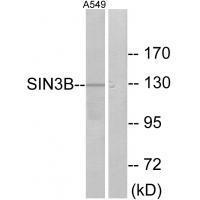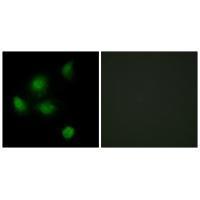

| WB | 咨询技术 | Human,Mouse,Rat |
| IF | 咨询技术 | Human,Mouse,Rat |
| IHC | 咨询技术 | Human,Mouse,Rat |
| ICC | 1/100-1/500 | Human,Mouse,Rat |
| FCM | 咨询技术 | Human,Mouse,Rat |
| Elisa | 咨询技术 | Human,Mouse,Rat |
| Aliases | Paired amphipathic helix protein Sin3b; Transcriptional corepressor Sin3b; Histone deacetylase complex subunit Sin3b; SIN3B; KIAA0700 |
| Entrez GeneID | 23309; |
| WB Predicted band size | 130kDa |
| Host/Isotype | Rabbit IgG |
| Antibody Type | Primary antibody |
| Storage | Store at 4°C short term. Aliquot and store at -20°C long term. Avoid freeze/thaw cycles. |
| Species Reactivity | Human |
| Immunogen | Synthesized peptide derived from internal of human SIN3B. |
| Formulation | Purified antibody in PBS with 0.05% sodium azide. |
+ +
以下是3篇涉及SIN3B抗体的研究文献示例(注:文献标题和作者为示例性概括,具体请以实际检索结果为准):
1. **标题**:*SIN3B interacts with histone deacetylases to regulate chromatin silencing and transcriptional repression*
**作者**:Zhang Y, et al.
**摘要**:研究利用SIN3B特异性抗体进行染色质免疫沉淀(ChIP),证实SIN3B与HDAC1/2形成复合物,通过去乙酰化修饰抑制靶基因转录,参与细胞周期调控。
2. **标题**:*SIN3B deficiency promotes colorectal cancer metastasis through dysregulating miR-200 expression*
**作者**:Wang L, et al.
**摘要**:通过Western blot和免疫组化(使用SIN3B抗体)发现,SIN3B在结肠癌中低表达,其缺失通过上调miR-200家族增强上皮-间质转化(EMT),促进肿瘤转移。
3. **标题**:*The role of SIN3B in maintaining embryonic stem cell pluripotency*
**作者**:Johnson DS, et al.
**摘要**:研究使用SIN3B抗体进行免疫荧光和Co-IP实验,揭示SIN3B通过与OCT4/SOX2相互作用,调控多能性相关基因的染色质状态,维持胚胎干细胞自我更新。
4. **标题**:*SIN3B-mediated chromatin remodeling is essential for DNA damage response*
**作者**:Chen J, et al.
**摘要**:通过siRNA敲低和SIN3B抗体验证,发现SIN3B招募ATM激酶至DNA损伤位点,调控组蛋白H2AX磷酸化,影响细胞对辐射损伤的修复能力。
(提示:实际文献需通过PubMed或Google Scholar以“SIN3B antibody” + 研究领域关键词检索获取。)
The SIN3B antibody is a crucial tool for studying the SIN3B protein, a key component of the SIN3 transcriptional regulatory complex. SIN3B, along with SIN3A, serves as a scaffold for histone deacetylases (HDACs) and other chromatin-modifying enzymes, playing a central role in gene expression regulation by modifying chromatin structure. It is involved in diverse cellular processes, including cell cycle progression, differentiation, apoptosis, and DNA repair. SIN3B interacts with transcription factors such as E2F, Myc, and nuclear receptors, enabling context-dependent repression or activation of target genes. Dysregulation of SIN3B has been implicated in cancers, neurodegenerative disorders, and developmental defects.
The SIN3B antibody is widely used in techniques like Western blotting, immunoprecipitation (IP), chromatin immunoprecipitation (ChIP), and immunofluorescence to analyze SIN3B expression, protein-protein interactions, and subcellular localization. Specific validation steps—such as siRNA/CRISPR knockout controls and cross-reactivity checks with SIN3A—are essential due to structural similarities within the SIN3 family. Antibodies are available in various clonal formats (polyclonal/monoclonal) and host species (rabbit, mouse), with selection depending on experimental needs. Researchers frequently employ SIN3B antibodies to investigate its role in epigenetic silencing, cancer metastasis, and stem cell maintenance, making it indispensable for dissecting transcriptional regulation mechanisms in health and disease.
×